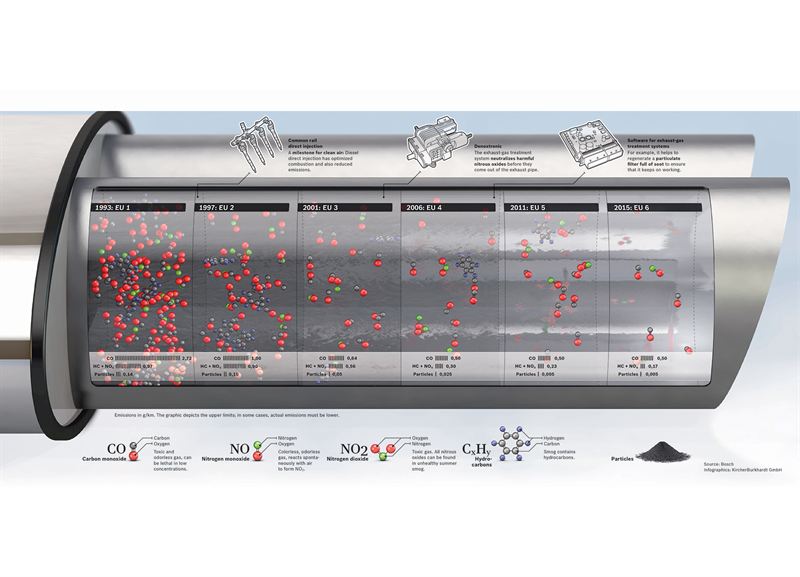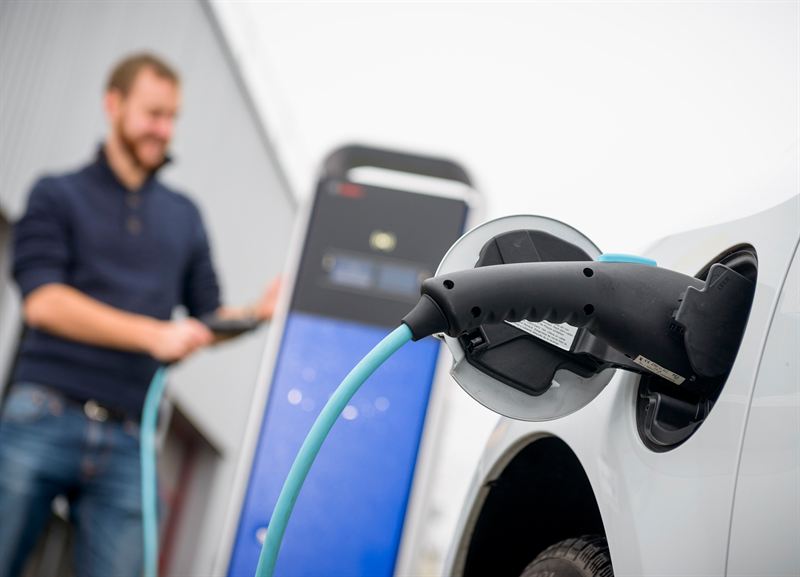Electrification and internet in the car: how Bosch is linking new technologies to petrol and diesel
- Petrol engines: 350 bar for direct injection cuts particulate emissions
- Diesel engines: 48-volt hybrid to reduce nitrogen oxide emissions
- Dr. Rolf Bulander: "Bits and bytes are making cars more efficient"

Bosch has revealed a number of innovations at the International Vienna Motor Symposium, which promise to offer economical, low-emissions vehicles that are also safe, with more convenience and engine performance.
“Bosch technology is making cars more efficient, more convenient, and more fun to drive,” said Dr. Rolf Bulander, member of the board of management of Robert Bosch GmbH and chairman of the Mobility Solutions business sector.
Connected electronic horizon: efficiency thanks to real-time data
Innovative advances will transform automotive powertrains over the next few years. “Electrification and connectivity will give a further boost to gasoline and diesel engines,” predicted Bulander. “Bits and bytes are making cars more efficient.” Electrified vehicles stand to gain tremendous benefits from connectivity. They are safer, more efficient, and more fun to drive. One example of how this works is the connected electronic horizon. In the future, this Bosch technology will supply essential traffic information about construction sites, traffic jams, and accidents in real time. From this basis, it will be possible to further improve existing functions such as start-stop coasting. At the same time, plug-in hybrids can use the system to implement a predictive operating strategy. Such technologies can cut CO2 emissions by a double-digit percentage.
Even after 2020, the vast majority of new cars will be powered by fossil fuels
In his presentation, Bulander reaffirmed that internal-combustion engines will remain the basis of efficient mobility. Even ten years from now, the vast majority of new vehicles worldwide will be powered by fossil fuels. Europe, the U.S., and China will raise the legal requirements for engine efficiency still further over that same period. Starting in 2021, the average new car in the EU will have an emissions cap of 95 g of CO2 per kilometer. Based on the current situation, advances in engine design should make it possible to achieve these values. The CO2 emissions for a petrol engine in the subcompact class can be reduced to 85g per kilometre, and for a diesel engine, that figure can be even lower than 70g per kilometre. Enhanced aerodynamics and reduced rolling friction could once again lead to further improvements. Vehicles in the premium class and SUVs will need additional electrification.

Engineering turns its attention to real driving emissions
In addition to current emission regulations, engineers are increasingly focusing on real driving emissions. The European Union is discussing whether to introduce real driving emission tests starting in 2017. This measuring method for diesel cars concentrates primarily on the emissions of nitrogen oxides and carbon monoxide in real-life driving situations. For cars with petrol direct injection, the focus is on the level of particulates emitted. A number of vehicles currently in production already expel an extremely low amount of emissions – for example, during rapid acceleration or at high speeds. Now it’s time to drive the spread of this capability and develop cost-effective technologies that will ensure compliance, whatever the driving conditions. Bosch presented several approaches at the International Vienna Motor Symposium that support this endeavour. Bulander put special emphasis on interlinking the domains of electrification, automation, and connectivity: “Bosch pools these aspects in the vehicle and creates ideal systems,” he said.
One example of this approach is the innovative direct injection system with laser-drilled spray holes in petrol engines. The holes’ precise edges swirl the fuel in the combustion chamber in such a way that it burns extremely efficiently. Increasing the injection pressure from 200 to 350 bar cuts particulate emissions to an even greater extent – especially under high load points and dynamic engine operation. Bosch debuted this refined version of its petrol direct injection system at the Vienna Motor Symposium.
In diesel engines, electrification reduces nitrogen oxide emissions right in the engine, making exhaust gas treatment still more efficient. Bulander demonstrated this by presenting Bosch’s new 48-volt boost recuperation system. Through the judicious application of boosts, the system can markedly reduce untreated nitrogen oxide emissions, especially at high loads or when the car is accelerating. The crucial factor here is that this effect cuts emissions directly at the point of combustion by up to 20 percent. This has the effect of significantly lowering exhaust pipe emissions: Bosch believes the system could allow the storage catalytic converter to reduce nitrogen oxide emissions by up to 80 percent. Electrification will also increase the level of efficiency for urea-based systems as well (SCR catalytic converters). These exhaust gas treatment applications consume much less AdBlue, which means the fluid doesn’t need to be refilled as often.
In the New European Driving Cycle, the 48-volt hybrid can also cut CO2 emissions by seven percent (based on compact class). Thanks to its electric-supported coasting, the car offers a smoother ride and can deliver up to 150 Nm more torque on demand.

Contact: Sabrina Mayeen, phone: +44 (0)1895 838813
Mobility Solutions is the largest Bosch Group business sector. In 2014, its sales came to 33.3 billion euros, or 68 percent of total group sales. This makes the Bosch Group one of the leading automotive suppliers. The Mobility Solutions business sector combines the group’s
expertise in three mobility domains – automation, electrification, and connectivity – and offers its customers integrated mobility solutions. Its main areas of activity are injection technology and powertrain peripherals for internal-combustion engines, diverse solutions for powertrain electrification, vehicle safety systems, driver-assistance and automated functions, technology for user-friendly infotainment as well as car-to-car and Car2X communication, repair-shop concepts, and technology and services for the automotive aftermarket. Bosch has been responsible for important automotive innovations, such as electronic engine management, the ESP
anti-skid system, and common-rail diesel technology.
The Bosch Group is a leading global supplier of technology and services. It employs roughly 360,000 associates worldwide (as per April 1, 2015). The company generated sales of 49 billion euros in 2014.* Its operations are divided into four business sectors: Mobility
Solutions, Industrial Technology, Consumer Goods, and Energy and Building Technology.
The Bosch Group comprises Robert Bosch GmbH and its roughly 440 subsidiary and
regional companies in some 60 countries. Including its sales and service partners, Bosch is represented in roughly 150 countries. This worldwide development, manufacturing, and sales network is the foundation for further growth. In 2014, Bosch applied for some 4,600 patents worldwide. The Bosch Group’s strategic objective is to create solutions for a connected life. Bosch improves quality of life worldwide with products and services that are innovative and spark enthusiasm. In short, Bosch creates technology that is “Invented for life.”
Additional information is available online at www.bosch.com, www.bosch-press.com, http://twitter.com/BoschPresse
*The sales figure disclosed for 2014 does not include the former joint ventures BSH Bosch und Siemens Hausgeräte GmbH (now BSH Hausgeräte GmbH) and ZF Lenksysteme GmbH (now Robert Bosch Automotive Steering GmbH), which have since been taken over completely.
Tags:




